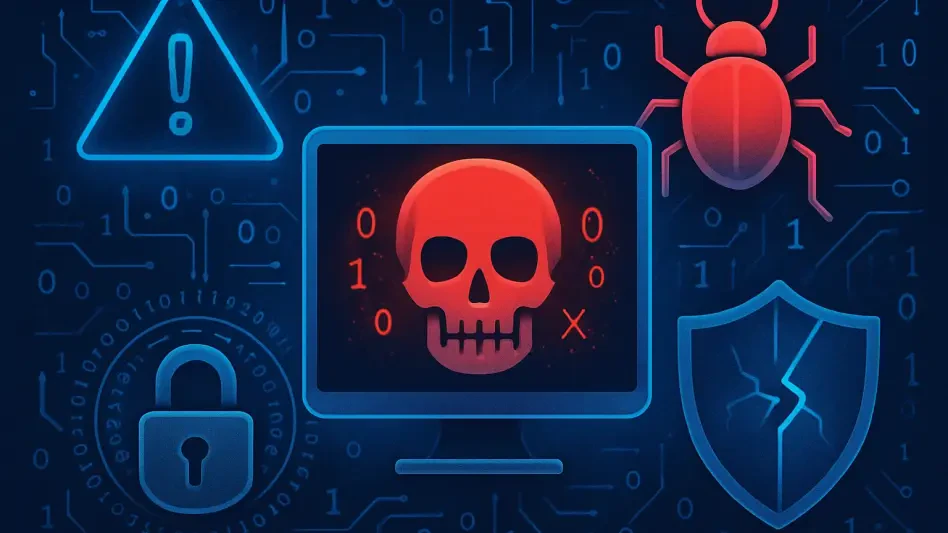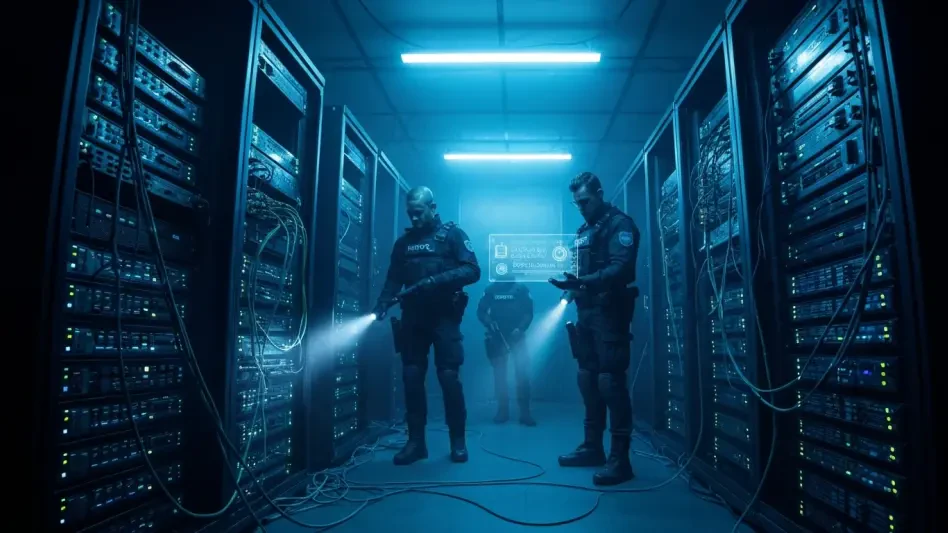In today’s digital landscape, where cyber threats are not just a possibility but a daily reality, the question of who shoulders the burden of defense has never been more urgent, especially as sophisticated attacks like zero-day vulnerabilities—flaws exploited before developers even know they exist—strike with alarming frequency. These attacks target everything from small businesses to critical national infrastructure. For years, the Cybersecurity and Infrastructure Security Agency (CISA), a federal entity under the Department of Homeland Security, has stood as a bulwark against these dangers, providing guidance and coordination since its establishment. However, recent budget cuts, layoffs, and policy uncertainties have cast a shadow over its future, raising a critical concern: can organizations and individuals safeguard themselves without federal support? As cyber risks evolve in complexity, the answer remains uncertain, demanding a closer look at the current state of cybersecurity and the implications of diminished government involvement.
Escalating Dangers in the Digital Realm
The cyber threat landscape has grown increasingly perilous, with attacks becoming more frequent and intricate over time. Zero-day exploits, which are vulnerabilities targeted by malicious actors before any patch or fix is available, represent one of the most severe risks. These flaws leave systems exposed during the critical window before a solution can be deployed, often resulting in devastating consequences for organizations. From data breaches to ransomware, the impact can ripple across industries, disrupting operations and eroding trust. Malicious actors often strategically withhold knowledge of such exploits, waiting for the most opportune moment to strike for maximum damage. This calculated approach underscores the urgent need for robust defense mechanisms that can anticipate and respond to threats before they escalate into full-blown crises, highlighting the precarious position many entities find themselves in without a unified strategy.
Beyond the nature of specific threats, the sheer scale of cyber incidents adds another layer of concern for both public and private sectors. Small businesses, often lacking the resources of larger corporations, are particularly vulnerable, yet even major enterprises and government agencies have fallen victim to sophisticated campaigns. The interconnectedness of modern systems means that a breach in one area can quickly cascade, affecting countless others down the line. Consider the potential compromise of critical infrastructure—power grids, water systems, or transportation networks—where a single exploit could endanger public safety on a massive scale. As threat actors continue to refine their tactics, leveraging advanced tools and techniques, the challenge of staying ahead becomes monumental. Without a centralized effort to track and mitigate these risks, the fragmented responses of individual entities may prove insufficient against a backdrop of ever-evolving digital dangers.
The Cornerstone of Federal Cybersecurity Efforts
Since its formation, CISA has played an indispensable role in fortifying the nation’s cybersecurity posture by acting as a central hub for threat detection and mitigation. Operating without partisan bias or commercial interests, the agency collaborates with state, local, and private stakeholders to identify vulnerabilities and disseminate actionable intelligence. Its detailed advisories break down how specific threats, including zero-day exploits, can be exploited and offer concrete steps for mitigation, often slashing the time it takes for organizations to respond effectively. This rapid sharing of information has proven vital in preventing minor issues from snowballing into major breaches. By maintaining a broad, unbiased perspective, CISA provides a level of insight that individual companies, often constrained by competitive priorities or limited scope, struggle to replicate on their own.
Moreover, the agency’s efforts extend beyond mere reaction to proactive measures that shape a more resilient digital environment. Through initiatives like vulnerability exploration and partnerships with tech vendors, CISA helps uncover potential weaknesses before they are exploited, staying a step ahead of malicious actors. This forward-thinking approach is complemented by its role in fostering trust across sectors, encouraging information sharing that might otherwise be stifled by rivalry or confidentiality concerns. The absence of business-driven motives allows the agency to prioritize public good over profit, ensuring that its guidance serves the widest possible audience. As cyber threats grow in sophistication, this impartial, comprehensive support becomes even more critical, acting as a linchpin for national defense strategies that protect both government entities and private citizens from the relentless pace of digital attacks.
Unraveling Support at a Critical Juncture
Despite its proven value, CISA faces an existential crisis that threatens to undermine the nation’s cybersecurity framework at a time when it is most needed. Significant budget reductions have led to the termination of a $10 million partnership with a key internet security organization, while layoffs affecting over a hundred staff members have further strained resources. These cuts come amidst growing uncertainty surrounding pivotal programs and legislation, such as the renewal of the Cybersecurity Information Sharing Act, which lacks clear commitment from current leadership. Such developments disrupt the flow of essential data that organizations rely on to preempt and counter threats. With cyber risks becoming harder to detect and mitigate, this erosion of federal capacity leaves a glaring gap in the coordinated response system that has long underpinned national security efforts.
Adding to the concern is the broader impact of these setbacks on the cybersecurity ecosystem as a whole. The loss of personnel and partnerships not only hampers CISA’s ability to operate effectively but also sends a discouraging signal to other entities invested in digital defense. Private companies and local governments, which often depend on federal guidance to align their strategies, may find themselves navigating an increasingly murky landscape without a reliable anchor. The timing of these challenges couldn’t be worse, as threat actors continue to exploit any sign of weakness with ruthless efficiency. Historical data shows that delayed responses to vulnerabilities often result in higher costs and greater damage, a risk that looms larger with each cut to federal support. As this crisis unfolds, the potential for systemic vulnerabilities to go unaddressed grows, placing unprecedented pressure on alternative mechanisms to pick up the slack.
Implications of a Federal Void
If CISA or similar federal bodies were to diminish significantly, the cybersecurity landscape would likely fragment into disjointed, uneven efforts that struggle to match the scale of modern threats. Private security researchers and bug bounty programs, while valuable in spotting specific flaws, cannot replicate the comprehensive, impartial oversight that a federal agency provides. Their efforts, often driven by narrow objectives or financial incentives, lack the breadth needed to address systemic risks across diverse sectors. Without a unifying force to consolidate findings and distribute actionable insights, critical vulnerabilities could slip through the cracks, leaving entire industries exposed. The absence of a centralized authority risks creating a patchwork of defenses that vary widely in effectiveness, amplifying the potential for widespread exploitation by determined adversaries.
Furthermore, the loss of federal leadership would exacerbate existing disparities in cybersecurity capabilities among different organizations. Large corporations with substantial budgets might bolster their defenses through in-house teams or third-party services, but smaller entities—such as local governments or startups—would likely struggle to keep pace. This uneven playing field could create weak links in the broader network, as attackers often target the least protected entry points to gain access to larger systems. Historical patterns of cyber incidents reveal that such gaps are frequently exploited, with cascading effects that undermine collective security. The impartial guidance and resource-sharing facilitated by federal agencies help level these disparities, ensuring a baseline of protection that benefits all. Without this support, the divide between the haves and have-nots in cybersecurity readiness could widen, posing a systemic threat to national stability in the face of relentless digital aggression.
The Growing Responsibility of Private Entities
As federal support for cybersecurity wanes, the responsibility to combat digital threats increasingly falls on private organizations and individual users, a shift that raises significant concerns. Many entities, especially smaller businesses or non-profits, lack the financial and technical resources to tackle sophisticated attacks independently. Even larger firms, while better equipped, often prioritize competitive interests over collective defense, limiting the sharing of critical threat intelligence. Industry leaders from prominent companies have publicly expressed unease about this trend, emphasizing that relying solely on private efforts is unsustainable without structured cooperation and clearer regulatory frameworks. The absence of federal coordination could result in slower identification of vulnerabilities, delayed responses, and ultimately, greater damage from breaches that might have been prevented with centralized support.
This shift also places an unfair burden on individuals who are often the end targets of cyber threats, yet lack the expertise or tools to protect themselves adequately. Phishing attacks, ransomware, and other schemes frequently exploit personal users as entry points to larger networks, making public awareness and defense capabilities crucial. Without federal initiatives to educate and equip citizens, the onus falls on private entities to fill educational and resource gaps, a role they are not always prepared or incentivized to take on. The ripple effects of this dynamic could undermine trust in digital systems, as repeated incidents erode confidence among consumers and businesses alike. Addressing this growing responsibility requires a fundamental rethinking of how private stakeholders operate, pushing for mechanisms that encourage collaboration over competition and ensure that even the smallest players have access to essential protective measures in an increasingly hostile online environment.
Building a United Front Against Digital Risks
In the face of diminishing federal involvement, the cybersecurity community must rally together with a level of collaboration that transcends traditional barriers. Competitive organizations, often hesitant to share proprietary data or strategies, need to recognize that collective defense is the only viable path forward against sophisticated threats. Building trust among stakeholders—whether private companies, independent researchers, or local authorities—is paramount to creating a network where information flows freely and resources are pooled for the greater good. Initiatives that incentivize such cooperation, perhaps through regulatory incentives or industry-led coalitions, could help bridge the gap left by reduced government support. The urgency to safeguard digital assets demands this united front, as isolated efforts will inevitably fall short against adversaries who operate with coordinated precision.
Beyond immediate collaboration, long-term strategies must focus on empowering all levels of society to contribute to cybersecurity resilience. This includes investing in education programs that equip individuals with the knowledge to recognize and mitigate risks, as well as supporting policies that streamline private-sector responses to emerging threats. Industry leaders have called for simplified regulations that reduce bureaucratic hurdles while fostering accountability, ensuring that protective measures keep pace with evolving dangers. Reflecting on past challenges, it’s evident that successful defenses often stemmed from shared commitment and innovative partnerships. Moving forward, the lessons learned from those efforts shape a path toward a more secure digital future, one where the absence of federal leadership is met with a determined, collective resolve to protect vital systems and data from relentless cyber adversaries.








